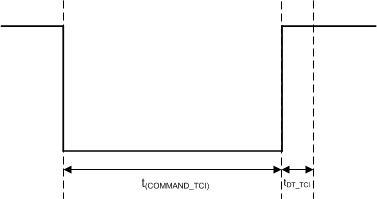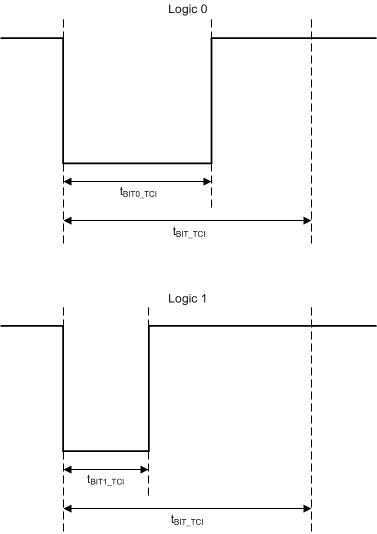SLASEJ4C April 2017 – February 2023 PGA460
PRODUCTION DATA
- 1 Features
- 2 Applications
- 3 Description
- 4 Revision History
- 5 Pin Configuration and Functions
-
6 Specifications
- 6.1 Absolute Maximum Ratings
- 6.2 ESD Ratings
- 6.3 Recommended Operating Conditions
- 6.4 Thermal Information
- 6.5 Internal Supply Regulators Characteristics
- 6.6 Transducer Driver Characteristics
- 6.7 Transducer Receiver Characteristics
- 6.8 Analog to Digital Converter Characteristics
- 6.9 Digital Signal Processing Characteristics
- 6.10 Temperature Sensor Characteristics
- 6.11 High-Voltage I/O Characteristics
- 6.12 Digital I/O Characteristics
- 6.13 EEPROM Characteristics
- 6.14 Timing Requirements
- 6.15 Switching Characteristics
- 6.16 Typical Characteristics
-
7 Detailed Description
- 7.1 Overview
- 7.2 Functional Block Diagram
- 7.3
Feature Description
- 7.3.1 Power-Supply Block
- 7.3.2 Burst Generation
- 7.3.3 Analog Front-End
- 7.3.4 Digital Signal Processing
- 7.3.5 System Diagnostics
- 7.3.6
Interface Description
- 7.3.6.1 Time-Command Interface
- 7.3.6.2
USART Interface
- 7.3.6.2.1 USART Asynchronous Mode
- 7.3.6.2.2 One-Wire UART Interface
- 7.3.6.2.3 Ultrasonic Object Detection Through UART Operations
- 7.3.6.3 In-System IO-Pin Interface Selection
- 7.3.7 Echo Data Dump
- 7.3.8 Low-Power Mode
- 7.3.9 Transducer Time and Temperature Decoupling
- 7.3.10 Memory CRC Calculation
- 7.3.11 Temperature Sensor and Temperature Data-Path
- 7.3.12 TEST Pin Functionality
- 7.4 Device Functional Modes
- 7.5 Programming
- 7.6 Register Maps
- 8 Application and Implementation
- 9 Device and Documentation Support
- 10Mechanical, Packaging, and Orderable Information
Package Options
Mechanical Data (Package|Pins)
- PW|16
Thermal pad, mechanical data (Package|Pins)
Orderable Information
7.3.6.1 Time-Command Interface
The time-command interface is the communication interface connected on the IO pin. The default state for the IO pin when the interface is idle is HIGH (pulled up to VPWR). The pin communication is bi-directional, where upon receiving a command, the PGA460 device is actively driving the IO pin and providing a response by changing the state of the IO pin. If the time-command interface remains stuck while transmitting a command or data for a particular command that is either LOW or HIGH for more than 15 ms, then the PGA460 communication resets and is expected to receive a new command transmission from the controller.
The time-command interface is specified by five time commands, where four are classified as run commands and one CONFIGURATION/STATUS command. Logic 0 is transmitted by pulling the IO pin low for a time duration of tBIT0_TCI and logic 1 is transmitted by pulling the IO pin low for time duration of tBIT1_TCI as defined in the GUID-6906D0A9-86EC-46B1-B4A5-F88035F60F0B.html#TITLE-SLASEC8TOCWRAPPER_SPECIFICATIONS section. #X4015 and #X5782 receptively show the general timing diagram for device time commands and for logic bit timing. The t(DT_TCI) dead-time is defined for the PGA460 device to process the received command and change the IO pin state from input to output.
 Figure 7-10 Time-Command Interface Command Timing
Figure 7-10 Time-Command Interface Command Timing Figure 7-11 Time-Command Interface Bit Timing
Figure 7-11 Time-Command Interface Bit Timing